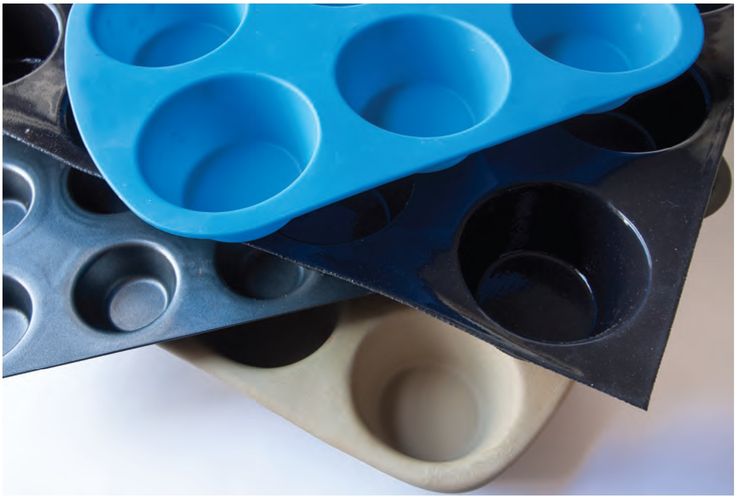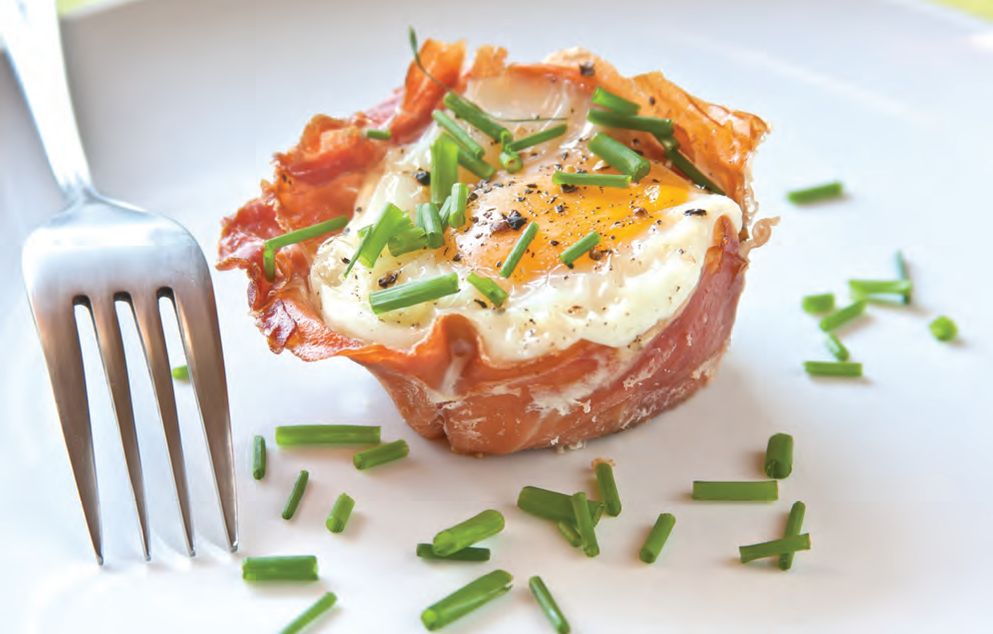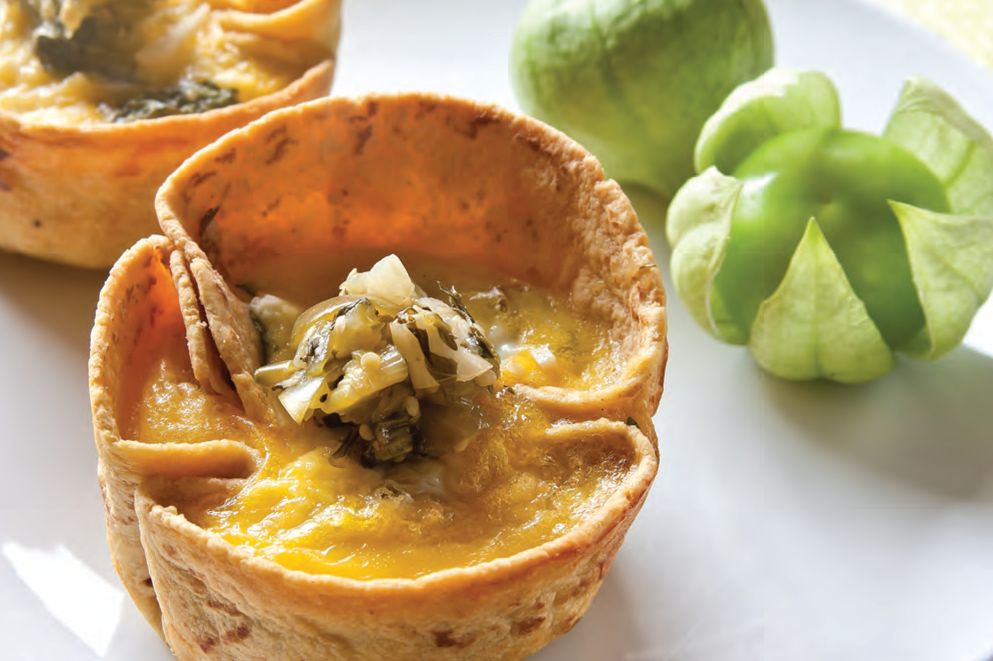Muffin Tin Chef (2 page)
Authors: Matt Kadey

Stoneware


 HUEVOS RANCHEROS WITH SALSA VERDE
HUEVOS RANCHEROS WITH SALSA VERDE
I was skeptical at first, but I now adore my rustic Pampered Chef stoneware muffin tray. Made from clay, it produces reliable results since heat distribution is even and the nonporous surface doesn't retain odors. If not using paper liners, the more you use stoneware, the more “seasoned” and nonstick it becomes. Similar to cast-iron, it's best not to use soap for cleaning purposes. If you end up with sticky bits on the bottom, simply boil some water, pour it into the cups, and let it sit for several minutes to loosen.
Thick, dense stoneware holds its heat, meaning it can continue to cook whatever is in the muffin molds after removal from the oven. For this reason, I try to pull out items such as muffins and mini cakes a couple of minutes earlier than a recipe calls for to prevent overcooked and dried out baked goods. Like silicone, do not use stoneware under the broiler.
Cast-IronAs they say, food just tastes better when cooked in heavy metal. Old-school cast-iron muffin trays produce crusty baked goods that brown nicely and evenly. Some cast-iron products such as those from Lodge come preseasoned for improved nonstick performance, but if you rescue one from Grandma's
attic, you'll probably want to season it again for better results. Cast-iron holds its heat exceptionally well, so similar to baking in stoneware, err on the side of pulling items out of the oven a little early, as they'll continue to cook while sitting in the tray post-oven. As with all cast-iron cookware, a little loving care (don't wash with soap and dry immediately) goes a long way to ensure a lifetime of great performance. Since it's made out of iron, some of the mineral likely gets transferred to the food during baking. This is particularly beneficial for premenopausal women who often have poor iron levels due to menstrual blood loss and inadequate dietary intake.
Size Mattersattic, you'll probably want to season it again for better results. Cast-iron holds its heat exceptionally well, so similar to baking in stoneware, err on the side of pulling items out of the oven a little early, as they'll continue to cook while sitting in the tray post-oven. As with all cast-iron cookware, a little loving care (don't wash with soap and dry immediately) goes a long way to ensure a lifetime of great performance. Since it's made out of iron, some of the mineral likely gets transferred to the food during baking. This is particularly beneficial for premenopausal women who often have poor iron levels due to menstrual blood loss and inadequate dietary intake.
Muffin tins generally come in three sizes: mini, medium, and jumbo.
Mini muffin trays that often have 12, 20, or 24 molds (holding about 2 tablespoons of batter each) per tray are great for making bite-size treats or a variety of crowd-friendly hors d'oeuvres.
Muffin trays with medium-size cups, sometimes called “standard” muffin trays, come with either 6 or 12 molds that hold about 1/2 cup each. This is the most versatile size for muffins, desserts, snack items, and savory side dishes.

Jumbo, or Texas-size, muffin trays most often have 6 individual cup molds and each has about a 1-cup capacity. They are an excellent option for hearty muffin tin main dishes.
A Sticky SituationIt's completely deflating to put your heart into a recipe only to have huge chunks of it stick to the bottoms of the muffin cups. With the exception of silicone trays, which rarely need coating, greasing muffin cups with a moderate amount of oil or butter can often stymie serious sticking. This is particularly important for egg-based muffin tin creations such as frittatas, as eggs have the tendency to stick like cement. Be sure to get the oil or butter into all the crevices. After cooking, letting the items cool for several minutes in the muffin tray can go a long way in helping ensure intact extraction.
As long as you don't mind the fluted surface they leave, another option to reduce the worry of sticking is paper liners. Look for unbleached options, or better yet, try out the liners from PaperChef. Their parchment cups are very much nonstick and completely biodegradable. Or if you run out of liners, you can improvise with some parchment paper cut into squares, which can give items an elegant, Martha Stewartâworthy presentation. Greasing the muffin cups helps keep the parchment paper in place.
How to Use This BookAccompanying many of the recipes on the following pages are these symbols:
V
Recipe is vegetarian, meaning it does not contain any meat or seafood. It may contain eggs or dairy.
Recipe is vegetarian, meaning it does not contain any meat or seafood. It may contain eggs or dairy.
G
Recipe is free of any gluten-containing products such as wheat flour. When purchasing items like oats or soy sauce, opt for those labeled “gluten-free.”
Recipe is free of any gluten-containing products such as wheat flour. When purchasing items like oats or soy sauce, opt for those labeled “gluten-free.”
F
Recipe can be frozen for later use.
Recipe can be frozen for later use.
Many recipes can be altered by substituting ingredients based on what's in your pantry and what your palate prefers. If you have special dietary needs, I'm confident you can work within the spirit of the recipe to make something similar that works for you. For example, if gluten tussles your tummy, you could use gluten-free bread crumbs or crushed puffed brown rice cereal when making individual shepherd's pies (page 90), or try
textured vegetable protein when rustling up taco cups (page 78) to ensure they're vegetarian friendly.
textured vegetable protein when rustling up taco cups (page 78) to ensure they're vegetarian friendly.
Cooking times are approximate. Ovens can vary greatly with respect to the amount of heat they produce and retain. You may want to check for doneness about a minute or two before the cooking time indicated in the recipe. If your oven heats unevenly, try rotating the muffin tin halfway through the baking time.
Most often, I don't mention the need for greasing the muffin cups in the recipe instruction as this depends on the type of tray you use. For example, silicone trays rarely require it, but if using metal or stoneware, assume that it's always a good idea to apply a light coating of oil or butter. In reality, the extra calorie load this creates is negligible. I'm not a fan of oil sprays as they tend to leave a sticky residue and have an ingredient list with too many whatchamacallits. Better options for greasing are vegetables oils such as coconut or grapeseed and good old-fashioned butter. As the product cooks up, this little bit of fat on the bottom helps brown the undersides of baked goods, giving them a toasty mouthfeel. For intact extraction, always allow cooked items to cool in the muffin cups before attempting to unmold.
As much as possible, I try to base recipes on whole foods, as these provide a bigger nutritional payoff than more processed ingredients. For example, I almost always try to swap out all-purpose flour for more nutrient-dense whole wheat pastry flour. More flavorful coconut palm sugar, called for in many recipes, is a definite step-up from heavily refined white sugar.
MORNING GLORIES: BREAKFAST & BRUNCH
As the old saying goes, “breakfast is the most important meal of the day.” It's true! A raft of research shows that consuming a well-balanced breakfast can improve concentration and help one maintain a healthy body weight, the latter likely by revving up metabolism and helping you avoid vending machine temptation later in the day. Studies also suggest breakfast eaters have an overall diet that is richer in dietary fiber, vitamins, and minerals. But maybe you've fallen into a breakfast rutâserving up the same bowl of cereal or plate of fried eggs every morning has left you a little blasé about your daybreak meal. Well, these muffin tin breakfast ideas are a fun and tasty way to break out of it.
In a perfect world, we'd all sit down every morning to a leisurely, healthy breakfast. In the real
world, however, most of us do our fair share of eating breakfast in the car, in front of the computer, or on the subway as mornings become a hectic blur of chores. Instead of picking up a calorie-bomb elephantine bagel or muffin on the go, opt for some of the recipes that follow such as baked oatmeal, bacon and egg cups, and orange popovers that are healthier alternatives when you're in a need for speed. Others, including polenta egg and sausage cups, and peach-stuffed French toast cups, are best enjoyed on a lazy weekend morning when you can afford the time to properly embrace their extra prep time and delightful flavors. Regardless, the heavy use of whole grains and smart protein choices within these recipes will give you sustained energy, not a short blast followed by a mid-morning crash.
BAKED EGGS IN PROSCIUTTO CUPSworld, however, most of us do our fair share of eating breakfast in the car, in front of the computer, or on the subway as mornings become a hectic blur of chores. Instead of picking up a calorie-bomb elephantine bagel or muffin on the go, opt for some of the recipes that follow such as baked oatmeal, bacon and egg cups, and orange popovers that are healthier alternatives when you're in a need for speed. Others, including polenta egg and sausage cups, and peach-stuffed French toast cups, are best enjoyed on a lazy weekend morning when you can afford the time to properly embrace their extra prep time and delightful flavors. Regardless, the heavy use of whole grains and smart protein choices within these recipes will give you sustained energy, not a short blast followed by a mid-morning crash.
Prosciutto is a thinly sliced cured ham originally from Italy and a wonderful alternative to bacon in this recipe. Unlike most muffin tin creations, these don't make good leftovers, so only prepare what you can eat at once. They can also anchor a dinner meal. Serve with a crusty bread for dipping into the runny yolks.
Serves 3 G
Serves 3 G
12 thin slices prosciutto
2 tablespoons grainy mustard or Dijon mustard
1/4 cup finely chopped basil
1/3 cup grated Parmesan cheese (about 1 ounce)
6 large eggs
chopped fresh chives, for garnish salt and pepper
2 tablespoons grainy mustard or Dijon mustard
1/4 cup finely chopped basil
1/3 cup grated Parmesan cheese (about 1 ounce)
6 large eggs
chopped fresh chives, for garnish salt and pepper
Preheat the oven to 375°F. Grease 6 medium muffin cups with oil or butter and line each with 2 slices of prosciutto, enough to cover the bottom and sides completely. Spread mustard on the bottom of the prosciutto-lined cups, and top with basil and cheese. Press down lightly on the cheese to make room for the eggs.
Carefully crack an egg into each prosciutto cup. Season the tops of the eggs with salt and pepper. Place the muffin tray on a baking sheet to catch any egg overflow. Bake until the egg whites are set but the yolks are still slightly runny, about 17 minutes. Let cool for 5 minutes before unmolding. Garnish with fresh chives.
Â
BAKED EGGS IN PROSCIUTTO CUPS,
page 14
page 14

Â
HUEVOS RANCHEROS WITH SALSA VERDE,
page 16
page 16

A classic Mexican breakfast, huevos rancheros are eggs served on hot corn tortillas and smothered in fiery salsa. Here, the tortilla cups hold all the contents in a neat little package that's vivified with the bright flavors of a tomatillo salsa.
Serves 3 G, V
Serves 3 G, V
6 (5-inch) corn tortillas grapeseed or canola oil, as needed
1 cup canned pinto beans, drained and rinsed
1/2 teaspoon ground cumin
2/3 cup chopped fresh cilantro, divided
1/2 cup shredded pepper Jack cheese
6 large eggs, lightly beaten
1 cup canned pinto beans, drained and rinsed
1/2 teaspoon ground cumin
2/3 cup chopped fresh cilantro, divided
1/2 cup shredded pepper Jack cheese
6 large eggs, lightly beaten
Â
Salsa:
8 to 10 fresh or canned husked tomatillos, finely diced
1 jalapeño or serrano chile pepper, seeded and finely diced
2 green onions, white and green parts, thinly sliced
2 garlic cloves, minced grated zest and juice from 1/2 lime sliced avocado, to serve (optional) salt and pepper
1 jalapeño or serrano chile pepper, seeded and finely diced
2 green onions, white and green parts, thinly sliced
2 garlic cloves, minced grated zest and juice from 1/2 lime sliced avocado, to serve (optional) salt and pepper
Preheat the oven to 350°F. Heat the tortillas one at a time in a dry skillet over medium-high heat until soft and pliable, 15 to 20 seconds per side. Or, stack the tortillas and microwave on high power, uncovered, until warm and flexible, about 25 seconds. Brush both sides of the warm tortillas with oil. With the bottom of a glass, gently press the tortillas into 6 jumbo muffin cups. Don't worry if some of the tortilla folds inward.
In a medium bowl, mash together the pinto beans, cumin, and 1/3 cup of the cilantro with a potato masher or the back of a fork. Divide the bean mixture among the tortilla cups. Top each with an even amount of cheese and press down so there is room for the eggs. Pour the eggs evenly among the tortilla cups and season the tops with salt and pepper. Cook until the eggs have set, about 20 minutes. Let cool for several minutes before serving.
For the Salsa:
To make the salsa, toss together the tomatillos, jalapeño or serrano pepper, green onions, garlic, lime zest and juice, and the remaining 1/3 cup cilantro. Season to taste with salt and pepper. Cook in a medium skillet over medium heat until the tomatillos have softened, about 5 minutes.
To make the salsa, toss together the tomatillos, jalapeño or serrano pepper, green onions, garlic, lime zest and juice, and the remaining 1/3 cup cilantro. Season to taste with salt and pepper. Cook in a medium skillet over medium heat until the tomatillos have softened, about 5 minutes.
Other books
Do Not Go Gentle by James W. Jorgensen
Murder Gone A-Rye (A Baker's Treat Mystery) by Nancy J. Parra
Cassandra's Dilemma by Heather Long
Savage Bay by Christopher Forrest
Microsoft Word - MeantForEachOther.doc by Allison
La comunicación no verbal by Flora Davis
Filthy 3: A Dark Erotic Serial by Megan D. Martin
Empress of the Night by Eva Stachniak
2: Chocolate Box Girls: Marshmallow Skye by Cathy Cassidy
The Best American Science and Nature Writing 2014 by Deborah Blum